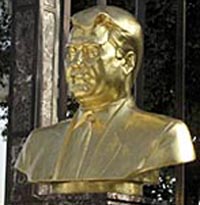Turkmen president immortalized himself before death
No matter where you went in Turkmenistan, there was no getting away from President Saparmurat Niyazov.

He's on every banknote and coin, his name heralded on billboards lining every main street. Golden statues of him are a landmark in every town. He was on TV and in newspapers, in schools and offices - his portrait even graces the cabin in planes run by the state airline.
Across Central Asia after the Soviet Union's 1991 collapse, signboards proclaiming the teachings of Vladimir Lenin were painted over with slogans preaching the newfound nationalism of the former local Communist leaders who held on to power.
But Niyazov, who died Thursday at age 66 of heart failure, had an exceptional flair for showmanship and put himself on display like few other authoritarian leaders. In a way, his regime was ironically transparent, allowing the public to see their leader in action on a regular basis.
Before the nightly news in Turkmenistan, a clock bearing the image of Niyazov glancing at his watch counted down the seconds for the latest bulletin.
The lead news item was always about the man called "Turkmenbashi," or "Father of all Turkmen," heading to villages for the harvest or meeting with visiting businessmen eager to get a cut of the country's energy spoils.
News broadcasts often lasted more than an hour - with the state-run channel's editors apparently wary of trimming anything about their leader.
A typical newscast would be a virtual "day in the life" of the president, starting with Niyazov driving his black Mercedes to work, then perhaps hopping on a helicopter to a village to watch farmers in action.
Residents would sing and dance to the delight of the rotund Niyazov, who would regally wave his burly hands decked with golden rings and clap softly. There would be speeches by elders, and perhaps the president himself would take a scythe to a wheat stalk.
No matter what else was on TV, a golden profile of Niyazov beamed from the corner of the screen - the logo of his self-proclaimed "Golden Century" for the country.
In case you missed it the night before, government newspapers would always report the president's doings as their top story the next day, the AP says.
In the capital of Ashgabat, the central landmark is a golden statue of Niyazov that rotates slowly during the day to face the sun. A grand cape flowing behind him had some residents joking privately that he looked like Batman. At night, lights make the statue visible even to planes landing at the city's airport.
Across the city are the beloved water fountains he erected despite the country's parched landscape.
All offices and schools are required to have rooms dedicated to studying a pseudo-philosophical tome authored by Niyazov called "Book of the Soul."
The book purports to trace the history of Turkmen, and is also a memoir of the president's life with touching moments - such as the young Niyazov tracking down friends of his father who died in World War II. Niyazov became an orphan after the rest of his family was killed in a 1948 earthquake that struck Ashgabat, the AP says.
The book has its own monuments, with a giant version of the pink-and-green covered volume gracing a central park that is home to yet more statues of Niyazov. Every evening, the book's cover mechanically opens.
The incessant propaganda doesn't mean the people of Turkmenistan are isolated from the world. Even though Niyazov sought to sever access to foreign media and travel, forests of satellite dishes sprout from apartment balconies where Turkmens turn to outside channels, often Russian, to get a relatively broader world view.
They are now watching to learn the fate of their country, where the omnipresent president gave few hints of a possible successor and the face that will be greeting Turkmens daily in the future.
Subscribe to Pravda.Ru Telegram channel, Facebook, RSS!





